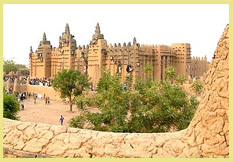




Lakes Of Ounianga - Chad
 Area: 628 km2
Area: 628 km2
Inscribed: 2012
Criteria:(vii) aesthetic
Location and Values: The Lakes of Ounianga are found in the heart of the Sahara Desert, in an area of northern Chad that receives no more than 2mm of rain annually. They depend on an underground supply of ‘fossil’ water that fell on the area in ancient times when the Saharan climate was much wetter than it is today. The lakes are situated in a shallow basin below sandstone cliffs and hills, from where the ancient water flows. Remarkably, this unique hydrological system is able to sustain the largest permanent freshwater lakes to be found in such an arid desert environment anywhere in the world.
There are 18 lakes altogether, in two groups about 40 km apart. They vary greatly in chemical composition, some being so salty that they can only support the most basic forms of life, while others are fresh enough to provide habitat for aquatic plants, fish and a diversity of other species. The largest and most biologically important lake (Lake Teli, in the eastern group known as Ounianga Serir) has a surface area of 4.4km2 and a maximum depth of 10 m. Its water is fresh, and supports an abundance of life. The sandy substrate is highly porous, so water flows freely underground between Lake Teli and 13 other smaller lakes in the eastern group. Further west, across the dunes and sandstone ridges that characterise this part of the Sahara, the second group of four lakes (known as Ounianga Kebir) is found, dominated by Lake Yoan (3.6 km2 and 27 m deep). This is a hyper saline lake which supports only algae and a few other micro-organisms. Rocks around its shores are encrusted in white salt deposits, and a sprawling village of some 9,000 people is spread amongst the nearby hills and dunes. There is a customs post, as this is the last habitable place on the main trans-Sahara truck route through to Libya (a little over 200 km further north).
By all accounts, the area is outstandingly beautiful, its golden dunes and natural sandstone hills, cliffs and wind-eroded ‘sculptures’, set against its palm-fringed lakes. A trickle of intrepid tourists (about 500 annually) finds its way to this remote corner of Chad.
Slideshow of the Lakes of Ounianga: None of our team has visited the Lakes of Ounianga, so we are still searching for suitable photos for a comprehensive slideshow. If you have any that you would be willing to share through this website, please Contact Us! In the meantime, a ‘remote’ (satellite) tour using Google Earth images is highly informative. The images begin by showing the context – two black marks in a vast expanse of sand represent the two groups of lakes. The tour then moves in closer, starting with the western group of lakes (Ounianga Kebir) and following the shoreline of Lake Yoan in an anticlockwise direction. Houses, roads and gardens are clearly visible, as well as the dunes, hills, rock outcrops and palm groves around the lake shore. The tour then moves east across the dunes and sandstone ridges to Ounianga Serir, the second group of lakes with its very distinctive form.
Associated with the technical evaluation of this recent world heritage nomination, IUCN has featured the Lakes of Ounianga on its website, and included a slideshow of the area which can be viewed here.
Google Earth View: To view satellite imagery of the Lakes of Ounianga on Google Earth, click here. This opens a new window, so when you are finished, just close the Google Earth page and you will be straight back here to continue browsing. The images of this part of the Sahara are exceptionally good allowing you to get a very good overall impression of the area.
Links to other places in the Deserts category: Air & Tenere | Tassili N’Ajjer
Other Links: Google Earth | Official UNESCO Site Details | IUCN Feature (with pictures)




.jpg)